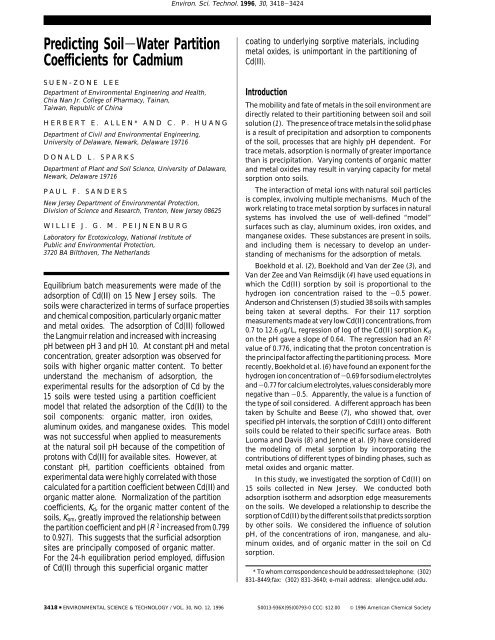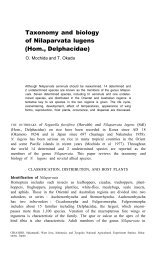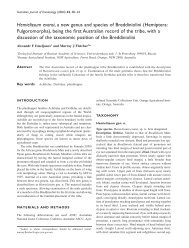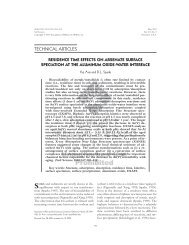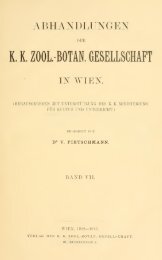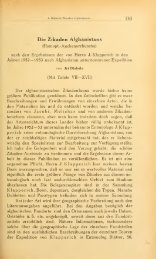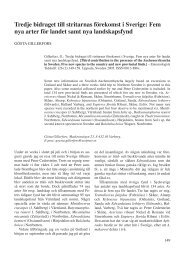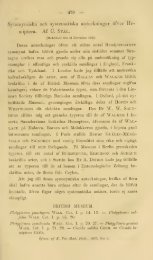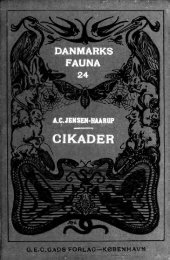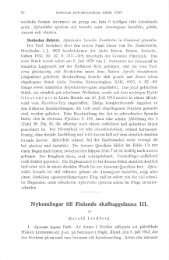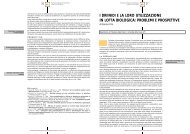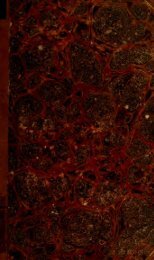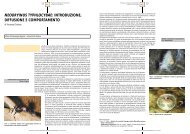Predicting Soil-Water Partition Coefficients for Cadmium
Predicting Soil-Water Partition Coefficients for Cadmium
Predicting Soil-Water Partition Coefficients for Cadmium
Create successful ePaper yourself
Turn your PDF publications into a flip-book with our unique Google optimized e-Paper software.
<strong>Predicting</strong> <strong>Soil</strong>-<strong>Water</strong> <strong>Partition</strong><br />
<strong>Coefficients</strong> <strong>for</strong> <strong>Cadmium</strong><br />
S U E N - Z O N E L E E<br />
Department of Environmental Engineering and Health,<br />
Chia Nan Jr. College of Pharmacy, Tainan,<br />
Taiwan, Republic of China<br />
H E R B E R T E . A L L E N * A N D C . P . H U A N G<br />
Department of Civil and Environmental Engineering,<br />
University of Delaware, Newark, Delaware 19716<br />
D O N A L D L . S P A R K S<br />
Department of Plant and <strong>Soil</strong> Science, University of Delaware,<br />
Newark, Delaware 19716<br />
P A U L F . S A N D E R S<br />
New Jersey Department of Environmental Protection,<br />
Division of Science and Research, Trenton, New Jersey 08625<br />
W I L L I E J . G . M . P E I J N E N B U R G<br />
Laboratory <strong>for</strong> Ecotoxicology, National Institute of<br />
Public and Environmental Protection,<br />
3720 BA Bilthoven, The Netherlands<br />
Equilibrium batch measurements were made of the<br />
adsorption of Cd(II) on 15 New Jersey soils. The<br />
soils were characterized in terms of surface properties<br />
and chemical composition, particularly organic matter<br />
and metal oxides. The adsorption of Cd(II) followed<br />
the Langmuir relation and increased with increasing<br />
pH between pH 3 and pH 10. At constant pH and metal<br />
concentration, greater adsorption was observed <strong>for</strong><br />
soils with higher organic matter content. To better<br />
understand the mechanism of adsorption, the<br />
experimental results <strong>for</strong> the adsorption of Cd by the<br />
15 soils were tested using a partition coefficient<br />
model that related the adsorption of the Cd(II) to the<br />
soil components: organic matter, iron oxides,<br />
aluminum oxides, and manganese oxides. This model<br />
was not successful when applied to measurements<br />
at the natural soil pH because of the competition of<br />
protons with Cd(II) <strong>for</strong> available sites. However, at<br />
constant pH, partition coefficients obtained from<br />
experimental data were highly correlated with those<br />
calculated <strong>for</strong> a partition coefficient between Cd(II) and<br />
organic matter alone. Normalization of the partition<br />
coefficients, Kd, <strong>for</strong> the organic matter content of the<br />
soils, Kom, greatly improved the relationship between<br />
the partition coefficient and pH (R 2 increased from 0.799<br />
to 0.927). This suggests that the surficial adsorption<br />
sites are principally composed of organic matter.<br />
For the 24-h equilibration period employed, diffusion<br />
of Cd(II) through this superficial organic matter<br />
Environ. Sci. Technol. 1996, 30, 3418-3424<br />
coating to underlying sorptive materials, including<br />
metal oxides, is unimportant in the partitioning of<br />
Cd(II).<br />
Introduction<br />
The mobility and fate of metals in the soil environment are<br />
directly related to their partitioning between soil and soil<br />
solution (1). The presence of trace metals in the solid phase<br />
is a result of precipitation and adsorption to components<br />
of the soil, processes that are highly pH dependent. For<br />
trace metals, adsorption is normally of greater importance<br />
than is precipitation. Varying contents of organic matter<br />
and metal oxides may result in varying capacity <strong>for</strong> metal<br />
sorption onto soils.<br />
The interaction of metal ions with natural soil particles<br />
is complex, involving multiple mechanisms. Much of the<br />
work relating to trace metal sorption by surfaces in natural<br />
systems has involved the use of well-defined “model”<br />
surfaces such as clay, aluminum oxides, iron oxides, and<br />
manganese oxides. These substances are present in soils,<br />
and including them is necessary to develop an understanding<br />
of mechanisms <strong>for</strong> the adsorption of metals.<br />
Boekhold et al. (2), Boekhold and Van der Zee (3), and<br />
Van der Zee and Van Reimsdijk (4) have used equations in<br />
which the Cd(II) sorption by soil is proportional to the<br />
hydrogen ion concentration raised to the -0.5 power.<br />
Anderson and Christensen (5) studied 38 soils with samples<br />
being taken at several depths. For their 117 sorption<br />
measurements made at very low Cd(II) concentrations, from<br />
0.7 to 12.6 µg/L, regression of log of the Cd(II) sorption Kd<br />
on the pH gave a slope of 0.64. The regression had an R 2<br />
value of 0.776, indicating that the proton concentration is<br />
the principal factor affecting the partitioning process. More<br />
recently, Boekhold et al. (6) have found an exponent <strong>for</strong> the<br />
hydrogen ion concentration of -0.69 <strong>for</strong> sodium electrolytes<br />
and -0.77 <strong>for</strong> calcium electrolytes, values considerably more<br />
negative than -0.5. Apparently, the value is a function of<br />
the type of soil considered. A different approach has been<br />
taken by Schulte and Beese (7), who showed that, over<br />
specified pH intervals, the sorption of Cd(II) onto different<br />
soils could be related to their specific surface areas. Both<br />
Luoma and Davis (8) and Jenne et al. (9) have considered<br />
the modeling of metal sorption by incorporating the<br />
contributions of different types of binding phases, such as<br />
metal oxides and organic matter.<br />
In this study, we investigated the sorption of Cd(II) on<br />
15 soils collected in New Jersey. We conducted both<br />
adsorption isotherm and adsorption edge measurements<br />
on the soils. We developed a relationship to describe the<br />
sorption of Cd(II) by the different soils that predicts sorption<br />
by other soils. We considered the influence of solution<br />
pH, of the concentrations of iron, manganese, and aluminum<br />
oxides, and of organic matter in the soil on Cd<br />
sorption.<br />
* To whom correspondence should be addressed:telephone: (302)<br />
831-8449;fax: (302) 831-3640; e-mail address: allen@ce.udel.edu.<br />
3418 9 ENVIRONMENTAL SCIENCE & TECHNOLOGY / VOL. 30, NO. 12, 1996 S0013-936X(95)00793-0 CCC: $12.00 © 1996 American Chemical Society
TABLE 1<br />
Physicochemical Properties of <strong>Soil</strong>s<br />
pH a<br />
Materials and Methods<br />
The 15 New Jersey soil samples are listed in Table 1. They<br />
are representative of the major soil types present in New<br />
Jersey.<br />
The soils were air dried, and agglomerates were broken<br />
by hand and by using a wooden mallet. Particles larger<br />
than 2 mm were removed by sieving. All further tests were<br />
per<strong>for</strong>med on the less than 2-mm size fraction of the soils.<br />
For the soil analyses presented in Table 1, organic matter<br />
was measured by the Walkey-Black wet combustion<br />
method; soil pH was determined in water; and soil particle<br />
size distribution was determined by a sedimentation<br />
(hydrometer) method (10). <strong>Soil</strong> metal oxides were determined<br />
by the ammonium oxalate extraction method of<br />
Iyengar et al. (11), using a Perkin Elmer Model 5000 atomic<br />
absorption spectrophotometer to analyze the solubilized<br />
metal. The natural Cd concentrations of the soils were<br />
negligible.<br />
Samples <strong>for</strong> the determination of adsorption isotherms<br />
were prepared by adding 1.0 g of soil to 100 mL of 0.01 M<br />
NaNO3. The pH was adjusted by the addition of small<br />
volumes of HNO3 or NaOH, as necessary, to attain the<br />
desired pHs of 4.0, 5.5, and 7.0. The initial Cd(II) concentrations<br />
ranged from 1.0 × 10 -6 to 5 × 10 -3 M, and the<br />
equilibration time was 24 h at room temperature (25 ( 2<br />
°C). Preliminary testing of Sassafras sandy loam and<br />
Washington loam at pH 4 and pH 7 established the adequacy<br />
of a 6-12-h equilibration time <strong>for</strong> these soils. After 24 h,<br />
the pH was readjusted to the initial value, and the samples<br />
were filtered through 0.45-µm membrane filters. The<br />
changes in pH after 24 h were small (all pH values were<br />
within (0.3 pH). The amount of adsorbed Cd was<br />
calculated as the difference between the amount added<br />
initially and that remaining in solution.<br />
Adsorption edge measurements were conducted <strong>for</strong> Cd-<br />
(II) <strong>for</strong> each of the 15 soils. The soil suspensions were 1.00<br />
( 0.01 g/100 mL. Ionic strength was maintained at 0.01 M<br />
with NaNO3. We added Cd(NO3)2 at a concentration of 1<br />
× 10 -4 M. Fifteen pH values covering the range from 3 to<br />
10 were employed. The pH values of the samples were<br />
adjusted by adding NaOH or HNO3 as required. Samples<br />
were shaken at 150 strokes/min on a reciprocating shaker<br />
(Lab-Line Instruments, Melrose Park, IL) <strong>for</strong> 24 h at room<br />
metal oxides (%) b<br />
soil type in water clay (%) Al Fe Mn<br />
temperature (25 ( 2 °C). The pH values were determined<br />
again after the 24 h of shaking. The samples were then<br />
filtered through 25 mm diameter, 0.45-µm membrane filters<br />
(Gelman Sciences, Ann Arbor, MI). The Cd(II) concentration<br />
in the filtered solution was determined by atomic<br />
absorption spectrophotometry.<br />
Results and Discussion<br />
organic<br />
matter (%)<br />
Birdsboro silt loam 5.69 18 0.714 1.035 0.025 2.2<br />
Boonton Bergen County 4.12 13 1.321 1.563 0.013 5.3<br />
Boonton Union County 5.14 16 1.447 0.773 0.065 8.6<br />
Downer loamy sand 4.74 8 0.120 0.076 0.0003 0.8<br />
Dunellen sandy loam 5.57 14 0.355 0.435 0.011 1.9<br />
Delaware River fill material 4.77 10 0.105 0.578 0.012 1.2<br />
Freehold sandy loam (A horizon) 6.44 6 0.442 0.519 0.009 0.2<br />
Freehold sandy loam (B horizon) 5.22 21 0.052 0.178 0.001 2.4<br />
Hazen gravelly loam 6.02 23 0.574 1.117 0.034 3.1<br />
Lakewood sand 4.18 6 0.096 0.344 0.0002 0.5<br />
Penn silt loam 4.67 27 0.593 0.743 0.022 1.3<br />
Rockaway stony loam 4.69 16 1.181 0.832 0.028 4.9<br />
Sassafras sandy loam 5.78 18 0.461 0.699 0.005 0.6<br />
Washington loam 6.03 31 0.684 0.900 0.038 2.9<br />
Whippany silty clay loam 6.17 37 0.388 0.736 0.004 2.3<br />
a <strong>Soil</strong> pH was determined after 30 min stirring and then 1 h standing. b Expressed as Al2O3, Fe2O3, and Mn2O3.<br />
<strong>Soil</strong> Characteristics. A summary of soil characteristics is<br />
presented in Table 1. The soils ranged from sand to silty<br />
clay loam; the range in clay content is 6 to 37%. <strong>Soil</strong> pH<br />
ranged from 4.18 to 6.44. Organic matter ranged from 0.2<br />
to 8.6%. The Boonton Union County soil had the highest<br />
concentration of aluminum and manganese oxides, whereas<br />
the Washington loam had the highest iron oxide content<br />
among the soils.<br />
Adsorption Isotherms. The adsorption data obtained<br />
from isotherm experiments were fitted by nonlinear<br />
regression (12) to Langmuir adsorption isotherms:<br />
[Cd] s ) ΓmK[Cd] w × 1000<br />
1 + K[Cd] w × 1000<br />
where [Cd]s is the cadmium concentration in soil (µg/g);<br />
[Cd]w is the cadmium concentration in water (µg/L); Γm )<br />
maximum sorbed cadmium concentration (µg/g); K is the<br />
constant (L/mg).<br />
Table 2 presents the values of the Langmuir Γm and K<br />
parameters from the nonlinear regression of [Cd]w vs [Cd]s.<br />
At a given pH, <strong>for</strong> example pH 7.0, the maximum adsorption<br />
concentrations, Γm, <strong>for</strong> the New Jersey soils varied widely,<br />
from 714 to 6469 µg/g, but correlated with the soil organic<br />
matter content (R 2 ) 0.812). At pH 7, the Boonton Union<br />
County soil had the greatest Γm, 6469 µg/g, and the highest<br />
concentration of organic matter, 8.6%, while the Freehold<br />
sandy loam (A horizon) had the smallest Γm, 714 µg/g, and<br />
the smallest concentration of organic matter, 0.2%. There<br />
was a much weaker relationship between Γm and soil iron,<br />
aluminum, or manganese oxides (R 2 ) 0.229, 0.599, and<br />
0.564, respectively at pH 7). Results <strong>for</strong> the other pH values<br />
were similar in that sorption correlated to organic matter<br />
much better than it did to the metal oxides.<br />
VOL. 30, NO. 12, 1996 / ENVIRONMENTAL SCIENCE & TECHNOLOGY 9 3419<br />
(1)
TABLE 2<br />
Parameters <strong>for</strong> Nonlinear Regression of Cs vs Cw of Langmuir Equation <strong>for</strong> Adsorption of <strong>Cadmium</strong> on 15<br />
New Jersey <strong>Soil</strong>s at Three pH Values<br />
soil type<br />
Γm<br />
(µg/g)<br />
Adsorption Edge. The most important factor controlling<br />
the partitioning of a metal to soil is the solution pH (13).<br />
In general, the percentage of a cationic metal adsorbed<br />
increases as pH increases with a transition range of 2-3 pH<br />
units in which the percentage of the metal that is adsorbed<br />
increases from nearly 0 to almost 100%. This transition<br />
range does not occur at the same value of pH <strong>for</strong> different<br />
soils. In this study, the extremes were represented by<br />
Boonton Union County soil and Freehold sandy loam (A<br />
horizon), which reach nearly 100% Cd(II) adsorption at pH<br />
6 and p 9, respectively (Figure 1). The high dependence<br />
of Cd(II) adsorption on pH is explained by the fact that<br />
hydrogen ions affect the surface charge of the adsorbent<br />
and the degree of ionization and the speciation of the<br />
adsorbate (14).<br />
<strong>Partition</strong> <strong>Coefficients</strong>. The ratio of the Cd concentration<br />
in the soil, [Cd]s, to the concentration of Cd(II) in the solution<br />
phase, [Cd]w, may be described by a partition coefficient<br />
(Kd, mL/g), which is a function of pH, metal concentration,<br />
and other properties of the solution and the solid matrix:<br />
We trans<strong>for</strong>med the partition data from the adsorption<br />
edges <strong>for</strong> the 15 soils into Kd values using the added and<br />
pH 4.0 pH 5.5 pH 7.0<br />
K<br />
(L/mg) R 2<br />
Γm<br />
(µg/g)<br />
K<br />
(L/mg) R 2<br />
Γm<br />
(µg/g)<br />
K<br />
(L/mg) R 2<br />
Birdsboro silt loam 1123 0.016 0.999 4113 0.027 0.998 3300 0.310 0.996<br />
Boonton Bergen County 930 0.043 0.995 2718 0.121 0.983 3977 0.357 0.956<br />
Boonton Union County 1864 0.037 0.996 6285 0.049 0.994 6469 0.847 0.989<br />
Downer loamy sand 2644 0.002 0.996 1208 0.075 0.996 2580 0.120 0.997<br />
Dunellen sandy loam 1123 0.017 0.998 3021 0.040 0.995 2897 0.245 0.998<br />
Delaware River fill material 886 0.014 0.997 1987 0.054 0.997 2161 0.210 0.999<br />
Freehold sandy loam (A horizon) 293 0.019 0.999 740 0.030 0.997 714 0.171 0.995<br />
Freehold sandy loam (B horizon) 942 0.004 0.996 2286 0.115 0.991 3170 0.277 0.981<br />
Hazen gravelly loam 1973 0.014 0.995 5110 0.050 0.997 4333 0.602 0.980<br />
Lakewood sand 161 0.034 0.985 323 0.215 0.999 826 0.378 0.998<br />
Penn silt loam 154 0.175 0.994 1174 0.095 0.996 1524 0.549 0.998<br />
Rockaway stony loam 1180 0.012 0.997 3370 0.048 0.995 3939 0.210 0.970<br />
Sassafras sandy loam 116 0.289 0.983 984 0.081 0.997 1124 0.297 0.998<br />
Washington loam 826 0.119 0.997 3038 0.075 0.998 2050 1.550 0.985<br />
Whippany silty clay loam 1273 0.075 0.997 1418 0.358 0.998 1968 0.821 0.996<br />
FIGURE 1. Adsorption of 1 × 10 -4 M cadmium onto Freehold sandy<br />
loam (A horizon) and Boonton Union County soil; the soils with the<br />
least and greatest adsorption. <strong>Soil</strong>/water ) 1 g/100 mL; I ) 0.01 M<br />
NaNO3; T ) 25 °C.<br />
K d ) [Cd] s<br />
[Cd] w<br />
3420 9 ENVIRONMENTAL SCIENCE & TECHNOLOGY / VOL. 30, NO. 12, 1996<br />
(2)<br />
FIGURE 2. Log Kd <strong>for</strong> Cd as a function of pH from Anderson and<br />
Christensen (5) <strong>for</strong> Danish agricultural soils (open symbols) and that<br />
from our laboratory <strong>for</strong> 15 New Jersey soils at their natural pH<br />
(closed symbols).<br />
equilibrium concentrations of Cd(II). The Cd in the soil<br />
was assumed be due solely to the adsorption of cadmium<br />
from the solution. The Kd values varied greatly from soil<br />
to soil. Figure 2 shows the large Kd data set of Anderson<br />
and Christensen (5) <strong>for</strong> Danish agricultural soils and that<br />
from our laboratory <strong>for</strong> 15 New Jersey soils at their natural<br />
pH. Although our solution concentrations (97.8-11 124<br />
µg/L) are much higher than those from Anderson and<br />
Christensen (0.7-12.6 µg/L), our log Kd values are still within<br />
the envelope of those of Anderson and Christensen. The<br />
slope of the regression <strong>for</strong> our soils (0.804) is about onethird<br />
higher than the value of 0.603 reported by Anderson<br />
and Christensen. Figure 3 shows all the adsorption edge<br />
data, trans<strong>for</strong>med into Kd values, plotted versus pH <strong>for</strong> all<br />
15 of our soils. Although it is clear from Figures 2 and 3<br />
that pH is the major factor controlling partitioning, the<br />
variation in Kd is still substantial. This indicates that<br />
although pH is the most important parameter, it is not the<br />
sole one.<br />
A portion of the removal of cadmium may have been a<br />
result of precipitation of CdCO3, but we believe that this<br />
is not likely as the media was NaNO3, and these soils<br />
contained little inorganic carbon. We evaluated whether
FIGURE 3. Log Kd as a function of pH <strong>for</strong> adsorption of cadmium onto<br />
15 New Jersey soils. <strong>Soil</strong>/water ) 1 g/100 mL; I ) 0.01 M NaNO3;<br />
T ) 25 ( 2 °C. Regression equation: log Kd ) -0.552 + 0.455 pH;<br />
R 2 ) 0.799.<br />
the high concentrations of cadmium used in the experiment<br />
invalidated the use of the linear partitioning relationship<br />
of eq 2 to describe the distribution between soluble and<br />
sorbed cadmium. We compared the partition coefficient<br />
obtained <strong>for</strong> the linear portion of the Langmuir isotherm<br />
using the constants at pH 5.5 in Table 2 to the experimental<br />
values of soluble and sorbed cadmium using eq 2. The<br />
mean deviation between these values <strong>for</strong> the 15 soils was<br />
51%, and the maximum deviation was a factor of 3. This<br />
difference is a small contribution to the scatter of our data<br />
in Figure 2 or Figure 3.<br />
In an attempt to better predict the partitioning of Cd to<br />
soil, a general partitioning model <strong>for</strong> the sorption of Cd(II)<br />
by soil surfaces at fixed pH was developed. The model<br />
uses fixed ionic strength and fixed initial metal concentration.<br />
A preliminary statistical analysis of the variation of<br />
Cd(II) adsorption with measured soil properties was made.<br />
Clay content and surface area showed low correlation to<br />
adsorption. Based on this analysis, the major adsorbing<br />
sites <strong>for</strong> binding Cd(II) are considered to be organic matter,<br />
and to a lesser degree, oxides of Fe, Al, and Mn.<br />
The reaction between Cd(II) and a single sorption phase,<br />
in which the ionic charge has been omitted, can be<br />
expressed as follows:<br />
tS + Cd / tS-Cd (3)<br />
K tSsCd ) [tSsCd]<br />
[tS][Cd]<br />
where KtSsCd is the conditional stability constant <strong>for</strong> the<br />
reaction; tS is a binding site on iron, aluminum, or<br />
manganese oxide or on organic matter; tSsCd is the<br />
quantity of Cd(II) sorbed by the binding site; [Cd] is the<br />
equilibrium Cd(II) concentration.<br />
The total quantity of the Cd sorbed by the soil, [tSsCd]tot,<br />
is the sum of the quantities of the Cd sorbed by the<br />
individual sorption phases:<br />
[tSsCd] tot ) [FeO x sCd] + [AlO x sCd] +<br />
[MnO x sCd] + [OMsCd] (5)<br />
The equilibrium Cd(II) concentration present in solution<br />
then can be obtained by consideration of the binding of<br />
(4)<br />
TABLE 3<br />
Conditional Stability Constants <strong>for</strong> Binding of Cd(II)<br />
by One, Two, and Three <strong>Soil</strong> Components at pH 5.0<br />
Cd(II) by all binding sites:<br />
conditional stability constants<br />
soil component<br />
considered KOM-Cd KAlOx-Cd KMnOx-Cd R 2<br />
OM a 29.98 0.941<br />
OM and Al 25.07 24.04 0.955<br />
OM, Al, and Mn 21.96 16.87 689.29 0.969<br />
a OM organic matter content. Sample calculation of predicted Kd by<br />
considering three components:<br />
K d ) 21.96[OM] + 16.87[AlO x ] + 689.29[MnO x ]<br />
[Cd] ) [tSsCd] tot /{KFeOxsCd [FeOx ] + KAlOxsCd [AlOx ] +<br />
KMnOxsCd [MnOx ] + KOMsCd [OM]} )<br />
where [tSi] is the concentration of the ith class of sorption<br />
sites; KtSisCd is the conditional stability constant <strong>for</strong> the<br />
reaction of Cd with the ith class of sorption sites.<br />
Rearranging eq 6:<br />
[Cd]<br />
[tSsCd] tot<br />
There<strong>for</strong>e, the partition coefficient is<br />
)<br />
[tSsCd] tot<br />
∑KtSisCd<br />
sites<br />
[tSi ]<br />
(6)<br />
Equation 8 was applied to the Cd(II) adsorption data <strong>for</strong><br />
the New Jersey soils. For each of the 15 soils, the adsorbed<br />
Cd is divided by the soluble Cd(II) to obtain experimental<br />
partition coefficients at the soil natural pH and at fixed pH<br />
values of 4.0, 5.0, and 6.0. Data <strong>for</strong> the fixed pH values<br />
were obtained by interpolation of the adsorption edge<br />
curves. These partition coefficients were regressed stepwise<br />
against site concentrations <strong>for</strong> the organic matter, and iron,<br />
aluminum, and manganese oxides using eq 8 to obtain<br />
conditional stability constants <strong>for</strong> each phase. The concentrations<br />
of organic matter and of the metal oxides were<br />
considered to be proportional to their site concentrations.<br />
Separate regressions omitted one or more sorption phases.<br />
These stability constants were then used to calculate<br />
predicted partition coefficients. The example equation<br />
shown in Table 3 utilizes stability constants <strong>for</strong> the binding<br />
of Cd(II) by organic matter, aluminum oxide, and manganese<br />
oxide to predict Kd. Boonton Union County soil,<br />
<strong>for</strong> example, contains 8.6% organic matter, 1.5% aluminum<br />
oxide, and 0.065% manganese oxide. The predicted Kd value<br />
(258.1 mL/g) at pH 5.0 is virtually identical to that observed<br />
(239.5 mL/g). We evaluate the success of including different<br />
components in the model by regression of experimental<br />
partition coefficients against partition coefficients calculated<br />
from the conditional stability constants. At soil natural<br />
pH, we found very low R 2 values (0.040-0.172, Table 4) <strong>for</strong><br />
the relation of the partition coefficient to the concentration<br />
of single or multiple potential binding sites. The inability<br />
1<br />
∑KtSisCd<br />
sites<br />
[tSi ]<br />
) 1<br />
K d<br />
(7)<br />
Kd ) ∑KtSisCd sites<br />
[tSi ] (8)<br />
VOL. 30, NO. 12, 1996 / ENVIRONMENTAL SCIENCE & TECHNOLOGY 9 3421
TABLE 4<br />
Comparison of R 2 <strong>for</strong> Regression of Experimental<br />
<strong>Partition</strong> <strong>Coefficients</strong> against Predicted Values<br />
Obtained from Conditional Stability Constants<br />
soil component<br />
considered natural pH pH 4.0 pH 5.0 pH 6.0<br />
OM b 0.104 0.928 0.958 0.966<br />
Fe 0.087 0.275 0.357 0.263<br />
Al 0.040 0.722 0.789 0.720<br />
Mn 0.105 0.705 0.684 0.593<br />
OM and Al 0.149 0.931 0.968 0.973<br />
OM, Al, and Mn 0.172 0.958 0.973 0.975<br />
a The regressions were per<strong>for</strong>med at three different pH values and<br />
at the natural pH of each of the soils by considering one, two, and three<br />
soil components in the model (eq 8). b OM, organic matter content.<br />
FIGURE 4. Correlation between experimental and predicted partition<br />
coefficient by considering organic matter only at three pH values.<br />
Line of equality is shown. R 2 ) 0.982.; 1 × 10 -4 M cadmium; soil/<br />
water ) 1 g/100 mL; I ) 0.01 M NaNO3; T ) 25 ( 2 °C.<br />
to relate the sorption of metal to the concentration of<br />
binding sites can be attributed to the fact that the effect of<br />
pH is not considered in this analysis.<br />
Table 4 also shows the comparisons of the results<br />
predicted by the model with the experimental data <strong>for</strong> three<br />
different pH values (4.0, 5.0, and 6.0) <strong>for</strong> the 15 soils. The<br />
single component that gives the best correlation is organic<br />
matter. A small improvement is obtained by including<br />
aluminum, but only a slight additional improvement is<br />
obtained when three components (organic matter, aluminum<br />
oxide, and manganese oxide) are considered. At each<br />
of the fixed pH values, this model fits the experimental<br />
data very well by considering organic matter as the only<br />
sorption phase (R 2 > 0.92). Of the four components<br />
considered, iron oxide was the least important to the binding<br />
of Cd(II) by the soils. Adding a second phase to the model<br />
gains only a marginal improvement at great cost in the<br />
<strong>for</strong>m of required additional in<strong>for</strong>mation that is difficult to<br />
experimentally obtain. Figure 4 shows the importance of<br />
organic matter to the binding of Cd(II).<br />
The differences in the regression model used in this study<br />
and that used by Anderson and Christensen (5) and many<br />
others should be noted. Their partitioning has been<br />
measured at natural soil pH, and soil pH has been included<br />
as one of the variables in the regression. This implies<br />
independence of pH from the other regression parameters.<br />
However, the extent of sorption of Cd(II) and other metals<br />
by metal oxides and organic matter is dependent on the<br />
pH. Consequently, pH must be fixed or the dependency<br />
3422 9 ENVIRONMENTAL SCIENCE & TECHNOLOGY / VOL. 30, NO. 12, 1996<br />
R 2<br />
FIGURE 5. Log Kom as a function of pH <strong>for</strong> adsorption of cadmium<br />
onto 15 New Jersey soils. <strong>Soil</strong>/water ) 1 g/100 mL; I ) 0.01 M<br />
NaNO3; T ) 25 ( 2 °C. Regression equation: log Kom ) 1.084 + 0.477<br />
pH; R 2 ) 0.927.<br />
TABLE 5<br />
Regression <strong>Coefficients</strong> <strong>for</strong> Log Kd vs pH (Figure 3)<br />
and Log Kom vs pH (Figure 5)<br />
regression n a slope intercept R 2<br />
log Kd vs pH 194 b 0.455 -0.552 0.799<br />
log Kom vs pH 194 b 0.477 1.084 0.927<br />
log Kd vs pH 136 c 0.478 -0.582 0.858<br />
log Kom vs pH 136 c 0.491 0.996 0.928<br />
log Kd vs pH 146 d 0.488 -0.666 0.698<br />
log Kom vs pH 146 d 0.522 0.892 0.951<br />
a Number of samples. b All data sets. c Samples with organic matter<br />
content less than 0.5% have not been included. d Samples with pH less<br />
than 3.5 and greater than 8.5 have not been included.<br />
of the sorption of metal by the sorbing phases must be<br />
explicitly included in the model. Since the later is difficult,<br />
we chose to fix the pH. Furthermore, consistent with eq<br />
8, we have <strong>for</strong>ced our regressions through the origin. This<br />
implies that in the absence of the sorption phases considered,<br />
there will be no sorption of Cd(II).<br />
To reduce the variance in the pH-dependent Kd’s that<br />
are shown in Figure 3, the Kd values were normalized to the<br />
organic matter content of the soils. Normalization of Kd<br />
to the amount of organic carbon is commonly done <strong>for</strong><br />
hydrophobic organic compounds (15, 16). The organic<br />
matter normalized partition coefficients, Kom, <strong>for</strong> the 15<br />
soils are plotted versus pH <strong>for</strong> the 15 soils in Figure 5. The<br />
data collapse to <strong>for</strong>m a single curve in which the data scatter<br />
is far less than was present in Figure 3. The regression<br />
parameters <strong>for</strong> Figures 3 and 5 are given in Table 5. When<br />
Kom rather than Kd is considered, the R 2 value increases<br />
from 0.799 to 0.927. Table 5 also shows the effect of<br />
truncating the data set. If soils have low concentrations of<br />
organic matter, the contribution of other binding sites, such<br />
as metal oxides and ion exchange sites on clay minerals,<br />
might be expected to become more important in the<br />
partitioning of Cd(II). When only samples with an organic<br />
matter content greater than 0.5% were included in the<br />
regressions, the R 2 value <strong>for</strong> the Kd vs pH regression<br />
increased from 0.799 to 0.858. The R 2 values <strong>for</strong> the<br />
regressions of Kom on pH were almost the same. The<br />
regression in Figure 5 deviates at both low and high pH. We<br />
have recently demonstrated that significant concentrations<br />
of organic matter dissolve from these soils at high pH (17).<br />
These organics would be expected to <strong>for</strong>m soluble com-
TABLE 6<br />
Predicted <strong>Partition</strong> <strong>Coefficients</strong> <strong>for</strong> 13 <strong>Soil</strong>s from The Netherlands (Data from Ref 19)<br />
soil<br />
plexes with Cd that would decrease the measured partition<br />
coefficient. Furthermore, in the Kom values we have not<br />
applied any correction <strong>for</strong> the solubilization of organic<br />
matter at higher pH.<br />
Application to Field <strong>Soil</strong>s. In our 24-h adsorption<br />
experiments, it was found that primarily the organic matter<br />
and not the metal oxides were involved in the sorption of<br />
the added Cd(II). This conclusion regarding the partitioning<br />
of Cd(II) in our work is in contradiction to that obtained<br />
from sequential fractionation data which show a distribution<br />
of Cd among various sorption phases (see, <strong>for</strong> example,<br />
ref 18 and references cited therein). The fractionations are<br />
of soils that are field contaminated and there<strong>for</strong>e aged. We<br />
believe that the results of our experiments demonstrate<br />
that organic matter is the surficial coating of the soil and,<br />
in the 24-h period that we used to equilibrate the samples,<br />
diffusion of the Cd to underlying metal oxide and other<br />
sorption phases was not important in controlling the<br />
partitioning of the Cd(II) between the soil and the solution<br />
phases. In a like manner, the desorption will be controlled<br />
by the equilibrium of Cd between the soil organic matter<br />
and soil water. The underlying oxide materials serve as a<br />
reservoir of Cd but do not affect the soil water concentration<br />
of cadmium. The uptake and release of Cd by these<br />
underlying metal oxide and other sorptive phases appears<br />
to be a diffusion controlled process.<br />
We have applied the model <strong>for</strong> Cd(II) partitioning that<br />
is shown in Figure 5 to data <strong>for</strong> 13 soils that were collected<br />
in The Netherlands (see Table 6) (19). The reported Kd<br />
values were computed from Cd released from the soil by<br />
nitric acid digestion and from measurements of Cd(II) in<br />
pore water. We predicted the log Kom using the equation<br />
presented in Figure 5. All predicted Kom values were within<br />
one order of magnitude of the measured Kom values. The<br />
mean deviation of log Kom was 0.241.<br />
Summary and Conclusions<br />
The results of both adsorption edge and adsorption<br />
isotherm studies showed that Cd(II) adsorption is highly<br />
pH dependent. The different soils have very different<br />
adsorption abilities. Among all soil properties, the organic<br />
matter plays the most important role in controlling Cd(II)<br />
sorption by soils.<br />
The adsorption coefficient (Kd) increases with increasing<br />
pH values. We have developed a model <strong>for</strong> the sorption<br />
of metal by soil surface substances at fixed pH. The results<br />
show that the conditional partition coefficients were highly<br />
correlated to the organic matter content at a fixed pH. The<br />
R 2 of the regression line was improved from 0.799 to 0.927<br />
when log Kom vs pH rather than log Kd vs pH was considered<br />
<strong>for</strong> the 194 measurements <strong>for</strong> the 15 soils that we investigated.<br />
We tested the model using data <strong>for</strong> soils from The<br />
Netherlands and were able to predict the partition coefficient<br />
within 1 order of magnitude <strong>for</strong> soils to which Cd(II)<br />
had not been added in the laboratory.<br />
For the 24-h equilibration period employed, diffusion<br />
of Cd through the superficial organic matter coating to<br />
underlying sorptive materials, including metal oxides,<br />
appears to be unimportant in the partitioning of Cd(II).<br />
Acknowledgments<br />
We would like to acknowledge the New Jersey Department<br />
of Environmental Protection, Division of Science and<br />
Research, <strong>for</strong> the support of this project under the Hazardous<br />
Waste Research Fund. The suggestion of Dr. Dominic<br />
DiToro and Dr. John Westall regarding the presentation of<br />
results is greatly appreciated.<br />
Literature Cited<br />
log Kom<br />
organic<br />
matter (%) pH Kd measured a predicted b<br />
measured -<br />
predicted<br />
A 7.0 6.0 810 4.063 3.946 -0.117<br />
B 73.3 4.7 583 2.901 3.326 0.425<br />
C 8.8 7.8 619 3.847 4.804 0.957<br />
D 39.1 6.0 2864 3.865 3.946 0.081<br />
E 2.6 4.0 9.0 2.539 2.992 0.453<br />
F 0.5 5.1 18.0 3.556 3.517 -0.039<br />
G 4.4 6.5 719 4.213 4.184 -0.029<br />
I 2.7 4.2 5.0 2.268 3.087 0.819<br />
J 4.6 7.8 872 4.278 4.804 0.526<br />
K 5.4 6.7 1211 4.351 4.280 -0.071<br />
L 7.6 4.5 83 3.038 3.231 0.193<br />
M 3.9 5.5 70 3.254 3.707 0.453<br />
N 4.4 6.0 1294 4.468 3.946 -0.522<br />
a Measured log Kom ) log (Kd × 100/% organic matter). b Predicted using the regression in Figure 5.<br />
(1) Evans, L. J. Environ. Sci. Technol. 1989, 23, 1046-1056.<br />
(2) Boekhold, A. E.; Van der Zee, S. E. A. T. M.; De Haan, F. A. M.<br />
<strong>Water</strong>, Air <strong>Soil</strong> Pollut. 1991, 57-58, 479-488.<br />
(3) Boekhold, A. E.; Van der Zee, S. E. A. T. M. <strong>Soil</strong> Sci. Soc. Am J.<br />
1992, 56, 747-754.<br />
(4) Van der Zee, S. E. A. T. M.; Van Reimsdijk, W. H. <strong>Water</strong> Res. Res.<br />
1987, 23, 2059-2069.<br />
(5) Anderson, P. R.; Christensen, T. H. J. <strong>Soil</strong> Sci. 1988, 39, 15-22.<br />
(6) Boekhold, A. E.; Temminghoff, E. J. M.; Van der Zee, S. E. A. T.<br />
M. J. <strong>Soil</strong> Sci. 1993, 44, 85-96.<br />
(7) Schulte, A.; Beese, F. J. Environ. Qual. 1994, 23, 712-718.<br />
(8) Luoma, S. N.; Davis, J. A. Mar. Chem. 1983, 12, 159-181.<br />
(9) Jenne, E. A.; DiToro, D.; Allen, H. E.; Zarba, C. Proceedings of the<br />
International Conference on Chemicals in the Environment;<br />
Lisbon, Portugal, 1986; Selper: London, 1986; pp 599-605.<br />
(10) Sims, J. T.; Heckendorn, S. E. Methods of <strong>Soil</strong> Analysis; University<br />
of Delaware <strong>Soil</strong> Testing Laboratory: Newark, 1991.<br />
(11) Iyengar, S. S.; Zelazny, L. W.; Martens, D. C. Clays Clay Miner.<br />
1981, 29, 29-43.<br />
(12) Wilkinson, L. SYSTAT <strong>for</strong> Macintosh, Version 5.2; SYSTAT:<br />
Evanston, IL, 1992.<br />
(13) Sposito, G. The Surface Chemistry of <strong>Soil</strong>s; Ox<strong>for</strong>d University<br />
Press: New York, 1984.<br />
VOL. 30, NO. 12, 1996 / ENVIRONMENTAL SCIENCE & TECHNOLOGY 9 3423
(14) Elliot, H. A.; Huang, C. P. <strong>Water</strong> Res. 1981, 15, 849-853.<br />
(15) Karickhoff, S. W.; Brown, D. S.; Scott, T. A. <strong>Water</strong> Res. 1979, 13,<br />
241-248.<br />
(16) Oepen, B. von; Kordel, W.; Klein, W. J. Chemosphere 1991, 22,<br />
285-304.<br />
(17) Yin, Y.; Allen, H. E.; Li, Y.; Huang, C. P.; Sanders, P. F. J. Environ.<br />
Qual. 1996, 25, 837-844.<br />
(18) Kersten, M.; Förstner, U. Speciation of Trace Elements in<br />
Sediments. In Trace Element Speciation: Analytical Methods and<br />
Problems; CRC Press: Boca Raton, FL, 1989; Chapter 8.<br />
3424 9 ENVIRONMENTAL SCIENCE & TECHNOLOGY / VOL. 30, NO. 12, 1996<br />
(19) Janssen, R. P. T.; Pretorius, P. J.; Peijnenburg, W. J. G. M.; van<br />
den Hoop, M. A. G. T. Proceedings of the International Conference<br />
on Heavy Metals in the Environment; Hamburg, Germany; CEP<br />
Consultants: Edinburgh, 1995; Vol. 2, pp 153-156.<br />
Received <strong>for</strong> review October 25, 1995. Revised manuscript<br />
received July 1, 1996. Accepted July 1, 1996. X<br />
ES9507933<br />
X Abstract published in Advance ACS Abstracts, October 1, 1996.


